Installing Hardware
Specifics vary, but most locksets come with paper templates that locate the center of the holes drilled in the face of the door (face bores) for handle spindles or cylinders and holes drilled into the edge of the door (edge bores) for latch assemblies. A second paper template locates holes drilled in the latch jamb of the door frame. Although the directions given in this section are typical, follow the directions supplied by your lock maker. Note: Measure the door thickness before buying locksets or key cylinders; some mechanisms are adjustable; others fit only specific door thicknesses.
Mortise locksets combine security and convenience, because you can use a single key to operate both a latch bolt and a dead bolt.
Mortise locksets house latch bolts and dead bolts in a single casing and can be operated with a single key turn. Mortising a lock case into the edge of the door takes some work, but the unit is very secure. The door stile must be solid wood for this type of lock.
1. Using the template, mark the edge of the door to indicate the outline of the lock case. Then mark a line running exactly in the center of the edge. Along this centered line, use a 18-in. spade bit to drill holes to the depth of the lock case. Overlap holes slightly to minimize the need for chiseling.
2. Use a chisel to square up the edges of the lock-case mortise. As you chisel, test-fit the lock case periodically to avoid chiseling away any more than necessary. When the lock case fits all the way into the hole, trace the outline of the main latch plate onto the edge of the door. Use a router to mortise the latch plate. Note: If the door edge is beveled, adjust the tilt of the latch plate to match the bevel beforehand.
3. Remove the lock case. Again, using the template, mark knob/spindle and key/cylinder holes on the face of the door stile. Use a hole saw to cut the cylinder hole and a Forstner bit or spade bit to cut the smaller spindle hole, holding drill bits perpendicular to the stile. Drill the holes
|
Use a chisel to square up the rounded corners of the latch-plate mortise. |
|
Drill the face bores, which were positioned by using a paper template. Use a hole saw for the larger, key/cylinder hole and a Forstner bit for the spindle or thumb-lever hole. The small round level taped to top of drill helps the installer drill perpendicular to the door face. |
|
Properly installed, the holes in the lock case will align with the holes drilled into the door face. If they don’t line up, use a rat-tail file to gradually enlarge the face bores. |
until the point of the bit just starts through the other side. To prevent splintering of the stile face, back the drill out and finish drilling from the other side.
4. Reinsert the lock case and screw it to the edge of the door. Then insert the spindles, slide the escutcheons over the spindles, attach the handles or knobs to the spindles, and see if they turn freely. Once they do, screw on all the trim hardware. Typically, door handles or thumb levers are 34 in. to 38 in. high.
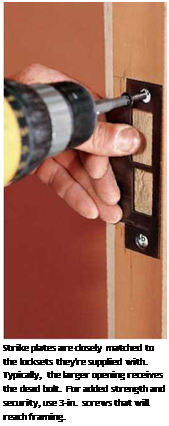 I Reinforced Strike-Plate Assembly
I Reinforced Strike-Plate Assembly
|
|
Because 3-in. screws anchor this assembly to framing behind the door frame, this strike plate can’t be dislodged by a kick.
5. ![]() You will also find a strike-plate template. The plate is often mortised into the latch jamb about 1 in. below the top of the latch plate; use a router to mortise the strike plate into the jamb. To more accurately position the leading edge of the strike plate, rub pencil lead on the latch edge; when the latch is released against the jamb, it will leave a pencil mark. For greater security, buy a unit with a strike-plate reinforcer and 3-in. mounting screws.
You will also find a strike-plate template. The plate is often mortised into the latch jamb about 1 in. below the top of the latch plate; use a router to mortise the strike plate into the jamb. To more accurately position the leading edge of the strike plate, rub pencil lead on the latch edge; when the latch is released against the jamb, it will leave a pencil mark. For greater security, buy a unit with a strike-plate reinforcer and 3-in. mounting screws.






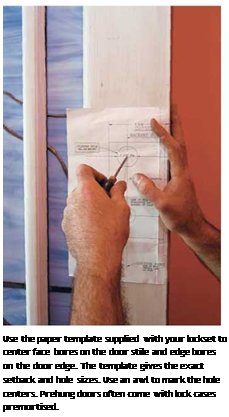
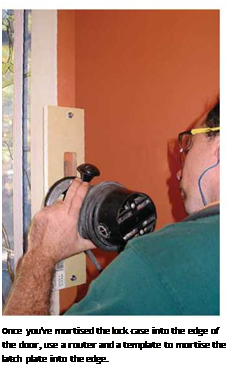
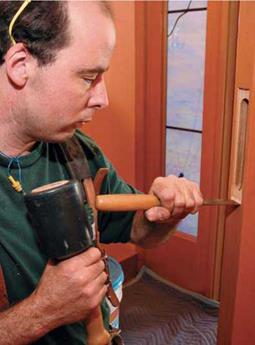
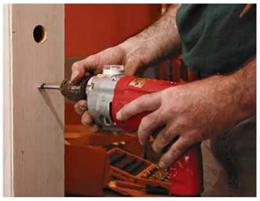
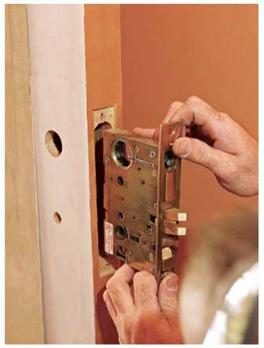
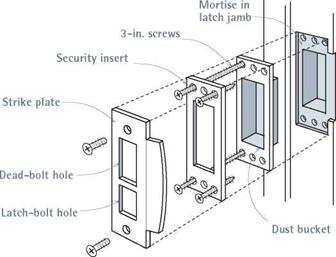
Leave a reply